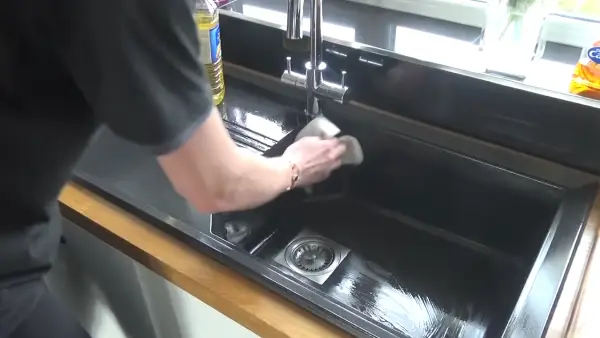Last Updated on November 12, 2023
Cleaning your brass sink in the kitchen can be a satisfying endeavor, bringing back its original luster and charm. Whether you’re dealing with tarnishes, stubborn stains, or just everyday grime, you have to follow a simple yet effective process.
To begin cleaning a brass sink, remove food particles and debris, thus creating a clean canvas for your cleaning efforts. Afterward, you’ll need to mix the right cleaning solution, such as mild dish detergent or vinegar.
Gently scrub your brass sink, paying particular attention to trouble spots, always working toward the sink’s grain. In the end, rinse the sink thoroughly with lukewarm water.
We will discuss all the steps in detail on how to clean a brass kitchen sink so it can regain its radiant shine.
How to Clean Brass Kitchen Sink: Step-By-Step Guide

If you would like to clean your brass kitchen sink, follow these steps:
- Step 1: Gather your cleaning supplies
- Step 2: Prepare the sink for cleaning
- Step 3: Make the cleaning solution
- Step 4: Apply the solution and scrub the brass kitchen sink
- Step 5: Rinse the sink
Step 1: Gather Your Cleaning Supplies
To effectively clean your brass kitchen sink, you need to gather all the necessary cleaning supplies before starting.
Find a soft, clean cloth or microfiber cloth that won’t scratch the surface.You will need lukewarm water to rinse the sink and a mild dish detergent to use as your basic cleaning solution.
Additionally, vinegar, table salt, and a lemon will come in handy for stubborn stains. For tough stains, have steel wool (#0000 grade) ready to use gently on the surface of your brass sink.
Step 2: Prepare the Sink for Cleaning
After collecting all the cleaning items, prepare the brass kitchen sink for cleaning. Remove any visible items around and inside the sink. This includes dishes, cutlery, or any debris present in the sink.
With these items safely stored elsewhere, you can now rinse the sink with lukewarm water. While rinsing, the water’s gentle flow will help break up any loose dirt particles in the sink.
Step 3: Make the Cleaning Solution
You can use a basic cleaning solution of mild dish detergent mixed with lukewarm water. For a more substantial cleaning job that needs more strength, you can mix flour, table salt, and distilled white vinegar to create a paste.
The paste will help remove stubborn stains without scratching the brass kitchen sink’s surface. Lastly, you can also opt for a commercial brass cleaner, which is effective in removing the toughest stains.
Step 4: Apply the Solution and Scrub the Brass Kitchen Sink
With the cleaning solution made, it’s now time to apply it to the sink. Dip a soft, clean cloth or microfiber cloth into the cleaning solution and start wiping the sink gently.
For any stubborn stains, apply the vinegar paste to the cloth and gently work it into the affected area. Ensure that you use a circular motion when cleaning so that the solution can penetrate every part of the sink.
When dealing with stains, be cautious of using steel wool as it can scratch the surface if applied too vigorously. Always follow the direction of the sink’s grain or finish.
Step 5: Rinse the Sink
Once you’ve cleaned the sink thoroughly, rinse it with lukewarm water to remove any residue from the cleaning solution.
Ensure that you’ve removed every trace of soap, vinegar, or commercial cleaner. Rinsing with clean water will help keep your brass kitchen sink looking shiny and sparkling clean.
Can you utilize tomato ketchup for cleaning a brass kitchen sink?
You can definitely try tomato ketchup to clean your brass kitchen sink, and it might surprise you with its effectiveness. Tomato ketchup contains acetic acid, which is known to break down tarnishes and stains on brass surfaces.
To clean your brass sink with ketchup, apply a generous amount of ketchup onto a soft cloth or sponge. Gently rub the ketchup onto the stained or tarnished areas of the sink, ensuring that the ketchup covers the entire surface.
Allow the ketchup to sit for a few minutes, giving it time to work its magic on the tarnish. Finally, rinse the sink thoroughly with water, removing all traces of ketchup.
After this simple cleaning method, you’ll be amazed at the shine and sparkle your brass sink will have.
Do you require polishing a brass kitchen sink after completing the cleaning process?

Polishing a brass kitchen sink is often recommended after completing the cleaning process to maintain its shine and protect it from tarnishing.
After you’ve cleaned the sink with ketchup, vinegar, or other cleaners, polishing can add an extra layer of protection.
There are various options available for polishing your brass sink. You can choose natural methods like using linseed or mineral oil to bring out a natural shine. These oils add luster to the sink and provide a protective layer, preventing tarnish from forming.
Alternatively, you can opt for commercial metal polish products specifically designed for brass surfaces. These polishes are formulated to remove any remaining stains or marks and restore the sink’s original shine.
Revel in the Sparkle: Clean Your Brass Sink for Long-Lasting Shine
Cleaning a brass kitchen sink is a simple and effective process that can bring back the radiance to your sink, regardless of tarnish, stains, or everyday grime. You can keep your brass sink looking its best after cleaning it with a cleaning solution.
Whether you opt for the traditional mild dish detergent, vinegar, or the surprising yet effective tomato ketchup, these methods will help you restore your sink’s shine.
We recommend polishing your brass sink for an added layer of protection using either natural oils or specialized brass metal polish. With these techniques, your brass kitchen sink will gleam with beauty for a long time.

